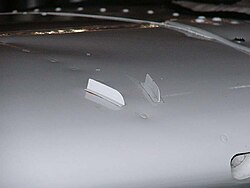STOL

A short takeoff and landing (STOL) aircraft is a fixed-wing aircraft that can takeoff/land on short runways. Many STOL-designed aircraft can operate on airstrips with harsh conditions (such as high altitude or ice). STOL aircraft, including those used in scheduled passenger airline operations, can be operated from STOLport airfields that feature short runways.
Design

STOL aircraft come in configurations such as bush planes, autogyros, and taildraggers, and those such as the de Havilland Canada Dash-7 that are designed for use on conventional airstrips. The PAC P-750 XSTOL, the Daher Kodiak, the de Havilland Canada DHC-6 Twin Otter and the Wren 460 have STOL capability, needing a short ground roll to get airborne, but are capable of a near-zero ground roll when landing.
For any plane, the required runway length is a function of the square of the stall speed (minimum flying speed), and much design effort is spent on minimizing this number. For takeoff, large power/weight ratios and low drag help the plane to accelerate for flight. For landing, the length is minimized by strong brakes, low landing speed, and thrust reversers or spoilers. Overall STOL performance is set by the longer of the runway needed to land or take off.

Of equal importance to runway length is the ability to clear obstacles, such as hills, beyond the runway. For takeoff, large power/weight ratios and low drag increase the rate of climb – required to clear obstacles. For landing, high drag allows the plane to descend steeply without building speed, which would require a longer ground run. Drag is increased by use of flaps on the wings and by forward slip (causing the plane to fly somewhat sideways to increase drag).
Typically, a STOL aircraft has a large wing for its weight. These wings may use aerodynamic devices like flaps, slots, slats, and vortex generators. Typically, achieving excellent STOL performance reduces maximum speed, but not payload ability. The payload is critical, because many small, isolated communities rely on STOL aircraft as their only link to the outside world for passengers or cargo; examples include many communities in the Canadian north and Alaska.
Most STOL aircraft can land either on- or off-airport. Typical off-airport landing areas include snow or ice (using skis), fields or gravel riverbanks (often using special fat, low-pressure tundra tires), and water (using floats): these areas are often short and obstructed by trees or hills. Wheel skis and amphibious floats combine wheels with skis or floats, allowing landing on snow/water.
Kits

A number of aircraft modification companies offer STOL kits for improving short-field performance.
- Crosswinds STOL of Wasilla, Alaska, sells STOL kits for light aircraft, including leading edge cuffs, tip spill plates, inboard flap extensions and STOL fences. The company offers kits for Piper PA-12, PA-14, PA-18, PA-20 and 22, Bellanca Champion Model 7 series, Cessna 170B, 180 and 185.
- Horton, Inc, of Wellington, Kansas, offers STOL kits under the brand name Horton STOL-Craft, emphasizing that the modifications increase safety by allowing forced landings to occur at lower speeds and thus improve survivability. The Horton modifications include a drooped leading edge cuff, conical cambered wingtips, control surface gap seals and wing fences. The company says: "On an average you can expect to get a 4-7 knot reduction in stall speeds. Flying at these lower stall speeds you can reduce the take-off and landing distances by 10%". Horton STOL kits are available for several Cessna and Piper PA-28 models.
- Micro AeroDynamics markets vortex generator modification kits for "STOL benefits". The Micro kits are small vortex generators that are glued to the wing leading edge, as well as the underside of the elevator and on the fin. Kits are available for a large number of light aircraft types.
- Sierra Industries sells Robertson STOL kits, marketed under the name R/STOL, incorporate a drooped leading edge cuff, wing fences, drooping ailerons and an automatic trim system. The company says that installation "allows 15 to 25 MPH slower approaches and requires up to 40% less runway distance". R/STOL kits are available for various Cessna models.
- Stolairus Aviation of Kelowna, British Columbia, has developed STOL Kits for the de Havilland Canada DHC-2 Beaver and de Havilland Canada DHC-3 Otter to increase lift and reduce stall speeds. The DHC-2 Beaver STOL Kit includes a contoured leading edge, flap-gap seals, wing fences and drooped wingtips. The DHC-3 Otter STOL Kit includes a contoured leading edge and drooped wingtips.
STOLport
CESTOL
Cruise-efficient short takeoff and landing (CESTOL) have very short runway requirements and cruise speeds greater than Mach 0.8.
Definitions
Many definitions of STOL have been used over time and for regulatory and military purposes. These include:
Some manufacturers market their products as STOL without specifying that the aircraft meets an accepted functional definition.
Rough-field capability
Rough-field capability is the ability to land/take-off from an unprepared/damaged runway or grass field, highway, wasteland or other ad hoc site. Rough-field capable aircraft usually have high wings, reinforced landing gear, and STOL capability.
List of rough-field capable aircraft
- AHRLAC Holdings Ahrlac
- Airbus A400M
- Arado Ar 232 Tausendfüßler
- British Aerospace 125
- Cessna A-37 Dragonfly
- Cessna Caravan
- General Atomics Mojave
- General Dynamics F-111 Aardvark
- PAC P-750 XSTOL
- Pilatus PC-24
- SEPECAT Jaguar
- Sukhoi Su-7
- Tupolev Tu-142
See also
References
External links
 The dictionary definition of STOL at Wiktionary
The dictionary definition of STOL at Wiktionary- Anatomy of a STOL Aircraft: Designing a Modern Short Take-Off and Landing Aircraft by Chris Heintz
- Blain, Loz (2025-03-22). "$9 billion in pre-orders for super-slow, super-quiet aircraft". New Atlas. Retrieved 2025-04-02.